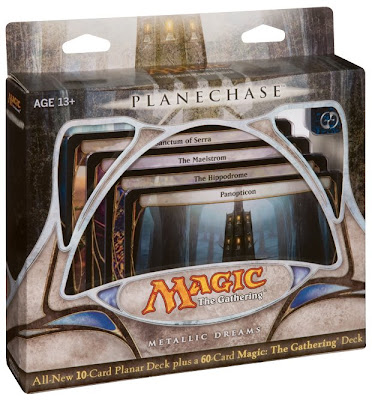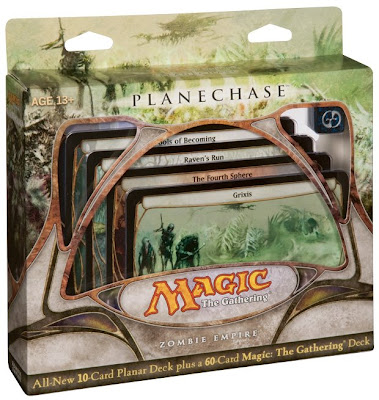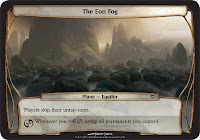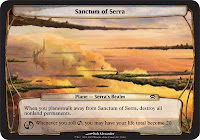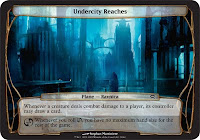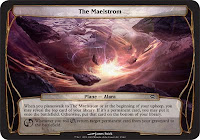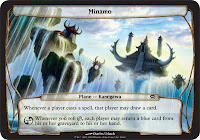
As with all of our spoiler lists, only fully revealed cards will be displayed here. Cards with missing game text will not be featured. Many of these cards were revealed in other languages and translated into English so the exact names and readings of the cards may differ. I have taken the liberty of creating the cards myself in a set editor so please forgive some of the artistic deformities. This is the nature of a Visual Spoiler. Stay tuned to this page and MTG Realm for the latest spoilers. Expect commentary weekly on the Gathering Magic main page as cards are revealed.
Discuss and Speculate in our MTG Spoiler Forum.
DECK LISTS AND PLANES LISTED BELOW!
Multiplayer Mayhem
The Planechase plane cards introduce a groundbreaking new way to experience planeswalking. Through this innovative new kind of card, two or more players can battle each other across a variety of diverse worlds, each with its own unique effect on the game. These thrilling new conditions add a whole new layer of chaos, meaning the only thing you can count on is unpredictability.
- There will be four Planechase Game Packs released on September 4th, 2009: Elemental Thunder, Metallic Dreams, Strike Force, and Zombie Empire.
- Each game pack will contain 10 all-new plane cards, a ready-to-play 60-card deck, a six-sided planar die and a Planechase strategy insert with multiplayer rules.
- Each of the 60-card decks will include 8 rares, and will be composed of cards from throughout Magic's history - including a preview card from Zendikar.
- The 10 oversized plane cards comprise a planar deck. They feature all-new artwork depicting some of the more exotic realms of the Magic multiverse.
- Each of the cards in the 60-card decks will be black-bordered and tournament legal. This means that these cards are legal for use in any tournaments where the original printings are still legal.
- Planechase release events will be held September 4-6, 2009.
Initial Concept and Game Design: Brian Tinsman (lead), Aaron Forsythe, Peter Knudson, and Kenneth Nagle
Final Game and Deck Development: Mike Turian (lead), Dave Guskin, Peter Knudson, Scott Larabee, and Mark Purvis, with contributions from Mark L. Gottlieb
Release Date: September 4th, 2009
MSRP: $19.99
What Is Planechase?
Planechase gives you everything you need to play Planar Magic, a new casual variant that sends you and your friends on a tour through the Multiverse. Each plane you visit—represented by a plane card—changes the nature of the battlefield. You never know how long you'll stay or where you'll go next, and the result is an ever-shifting race to exploit the unique nature of the plane you're on ... or to planeswalk away from a plane that your enemies can take advantage of!
We'll take a look at a plane card in a moment, but to know what you're looking at, you'll need a little bit of background.
Start the Journey
You can use Planechase rules in two-player games or your multiplayer variant of choice, but Planar Magic is intended for multiplayer free-for-all games with 3 to 6 players. Each player needs a normal minimum 60-card Constructed deck (such as, say, the one in each Planechase game pack) and a planar deck of at least 10 plane cards (fortuitously, also included in each game pack). Your planar deck is shuffled like your regular deck, and you can't look at or rearrange the cards in it.
You'll also need at least one planar die, also included in each game pack. The die has six faces, four of them blank. One face has the planeswalker symbol:

The last face has a new symbol on it. It's called the chaos symbol, but plane cards refer to it using the symbol itself. It looks like this:

Other than the rules for plane cards and the planar die, the game proceeds normally, including the victory condition. You win a multiplayer free-for-all game or a duel when all other players are eliminated, your team wins a team game when all other teams are eliminated, etc.
Now that you've got everything you need, you can get to the action. Determine who goes first, shuffle your decks, draw your hands, and resolve any mulligans as normal. Then, before the game starts, the player who's going to go first turns the top card of his or her shuffled planar deck face up. Let's say it's, oh, this one:

Plane cards are Magic cards, and the text on them follows most of the rules you're familiar with. Each plane card has a name, a type, a subtype, and at least two abilities. Oh, and gorgeous, all-new, landscape-oriented art, but that's not really a rules thing.
Before we look at the parts of a plane, take a look at these true facts about plane cards:
- At any given time, exactly one plane card will be face up, in a new game zone called the command zone. As long as a plane card is face up in the command zone, its abilities affect the game.
- They're never put onto the battlefield, and they're not permanents, so nothing can destroy or otherwise affect them.
- A plane card's controller is the player whose turn it is (although this can change when a player leaves the game; see Leaving the Game, below). When a plane card's abilities talk about "you," they're always talking about the plane's current controller. If the plane's abilities have targets, its current controller chooses them. The rules below will occasionally make a distinction between a plane card's owner and its controller.
Got all that? Now let's look at the parts of a plane card.

Name: A plane is a big place—way too big to fit on just one card—so each plane card represents just part of a plane. The card's name tells you which specific location you've arrived in on the plane to which you've planeswalked.

Type line: As with other Magic cards, this line contains the card's type, subtype, and expansion symbol. "Plane" is a card type, even though you never put plane cards in your regular Magic deck. Each plane card's subtype tells you what plane it's on. Among the plane cards' subtypes, you'll find a mix of familiar favorites, like Ravnica and Dominaria, and previously unseen planes like Moag and Zendikar. (What's that? There's a sneak peek of Zendikar in today's Arcana? Well, we suppose it won't be previously unseen, then ....)

Abilities: Generally speaking, each plane has one ability (the top one) that's "always on," and another (the bottom one, in the shaded part of the text box) that triggers when you roll the chaos symbol on the planar die. When do you roll the planar die? We're glad you asked.
Walk the Walk
Now that you know how to read a plane card, it's time to learn about planeswalking. You are a planeswalker, after all. Isn't it about time you took a stroll across the Multiverse?

During your turn, any time you could cast a sorcery, you may roll the planar die. You can do this multiple times in the same turn. To roll the die, you must pay an amount of mana equal to the number of times you've already rolled the die this turn. So the first roll is free, the second roll costs ![]() , the third roll costs
, the third roll costs ![]() , and so on. Rolling the die happens immediately (no one can respond to it), but any ability that triggers as a result goes on the stack, and can be responded to like other triggered abilities.
, and so on. Rolling the die happens immediately (no one can respond to it), but any ability that triggers as a result goes on the stack, and can be responded to like other triggered abilities.
Why might you want to reroll the die? Rolling the die could have three results:
- If you roll a blank face, nothing happens.
- If you roll the chaos symbol, the face-up plane card's chaos ability triggers. Players may cast instants and activate abilities before it resolves.
- If you roll the planeswalker symbol, the face-up plane card's unwritten planeswalking ability triggers. Players may cast instants and activate abilities before it resolves. When the planeswalking ability resolves, the owner of the face-up plane card puts it on the bottom of his or her planar deck, then you turn the top card of your planar deck face up. Welcome to a new world!

Some plane cards have abilities that trigger when you planeswalk to them or planeswalk away from them. These abilities trigger when the game shifts from one face-up plane card to another (but they don't trigger when the first plane of the game is turned face up). This shift might occur because the planeswalker symbol was rolled or because the player who owned the previous face-up plane card left the game. Speaking of which ....
Leaving the Game

In multiplayer games, unlike duels, you have to figure out what happens when a player leaves the game (because that player lost the game or conceded). Fortunately, there are rules for that sort of thing.
In any multiplayer game, when a player leaves the game, all permanents, spells, and other cards (including plane cards) owned by that player also leave the game, and any abilities or copies of spells that player controlled cease to exist. If that player controlled any permanents owned by another player, the effect(s) that gave that player control of them end(s), which usually means that they return to their previous controller(s). If that doesn't give control of them to a different player (perhaps because they entered the battlefield under the control of the player that left), they're exiled. If the player who left was taking his or her turn, that turn continues to its completion even though that player is now gone.
Now let's figure out what happens to the face-up plane card when one or more players leaves the game. The player(s) leaving the game might include that plane card's owner, its controller, both, or neither. First, check whether a departing player controls the plane. Then, whether or not that's the case, check whether a departing player owns the plane.
If the face-up plane card's current controller is leaving the game, the next player in turn order who's still in the game takes control of that plane just before the departing player leaves. Any planeswalking, chaos, or other abilities of that plane the departing player controls are removed from the stack, just like any other abilities that player controls.
Then, if the face-up plane card's owner is leaving the game, that card leaves the game as well. Its current controller (who may have just gained control of it) immediately turns the top card of his or her planar deck face up, triggering any "planeswalk to" or "planeswalk from" abilities. When that happens, any planeswalking abilities that were waiting to resolve will cease to exist (so you don't planeswalk twice). Any chaos abilities or other abilities of that plane that are still on the stack stay there and will resolve as normal.
The reason we get so specific about the timing of those steps is because, as we said, some cards have abilities that trigger when you planeswalk away from them. What sort of ability, you ask? Well, something like this:

If a departing player both owns and controls Sanctum of Serra, a new player takes control of it just long enough to put that ability on the stack. Boom!
Variants
The Planechase decks work great right out of the box, but that's just the beginning. You can customize the 60-card decks or swap them out for different decks entirely. But you can also customize your planar deck with any (or all!) of the 40 planes among the four game packs. There are only two rules about your planar deck's composition:
- Your planar deck must have at least ten cards in it.
- No two cards in your planar deck can have the same name.
Alternately, you can use the shared planar deck variant. This is perfect if you've got all four Planechase game packs, but your friends don't have any. It's also good if you'd prefer a more chaotic play experience, rather than one in which the planar decks are tailored to match the Constructed decks they're paired with.
The number of cards in the shared planar deck should be at least 40, or at least ten times the number of players in the game, whichever is smaller. No two cards in the planar deck can have the same name.
Because Planar Magic is a casual format, you can play it with any variations your group is willing to try out. You can try out Planar Two-Headed Giant, Planar Star, Planar Elder Dragon Highlander—whatever you want!
Velis Vel (Lorwyn / Shadowmoor), Murasa, Isle of Vesuva (Dominaria), Feeding Grounds
Strike Force
Glimmervoid Basin (Mirrodin), Academy at Tolaria West (Dominaria), Izzet Stream Maze (Ravinica), Stronghold Furnace (Dominaria)
Zoombie Empire
Pools of Becomming, Raven's Run (Lorwyn / Shadowmoor), The Fourth Spere (Phyrexia), Grixis (Alara)
Some skinny on the corporate -
MSRP of $19.99 : Quantities are limited.
Organized Play
* Launch Parties (with exclusive plane card for participation)
* Wizards Play Network “Featured Format”
* Exclusive plane card to be given out at Zendikar™ Prereleases
* Organized play events scheduled for 2009 will support attendance with exclusive plane cards.
KEY SELLING POINTS
* Planechase is a fun new multiplayer format for Magic: The Gathering. Plane cards represent different worlds in the Magic Multiverse. As the game moves from plane to plane, it has a fun and exciting impact on game play.
* Players can use plane cards with their own magic decks or the powerful 60-card decks that come with each game pack.
* The Planechase set has four different game packs available, each one with 10 unique plane cards and a 60-card preconstructed Magic deck.
* Each 60-card deck that comes with the Planechase game pack is composed of popular cards from throughout magic’s history and is tuned for multiplayer play. Each deck contains a 8 rare cards – the same total number that appear in Duel Deck releases.
* Each of the four 60-card decks also contains a different preview card from the October 2009 Magic set, ZendikarTM.
Deck Lists:
->Special thanks to our buddy over at MTG-REALM for the great image links! <-
Metallic Dreams
|
|
|
|
|
|
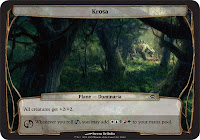 |
|
|
|
|
|
|
Metallic Dreams Decklist
1 Forest
8 Island
2 Mountain
3 Plains
3 Swamp
1 Gold Myr
1 Iron Myr
1 Pentavus
1 Qumulox
Strike Force
The 10 Planes you will get with Strike Force :
(click for full size images)
 |
 |
 |
 |
 |
 |
 |
 |
 |
 |
9 Mountain
9 Plains
2 Sunhome, Fortress of the Legion
Elemental Thunder
The 10 Planes you will get with Elemental Thunder :
(click for full size images)
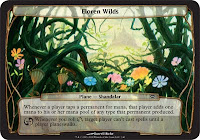 |
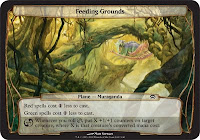 |
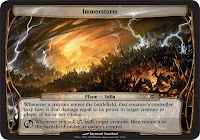 |
 |
 |
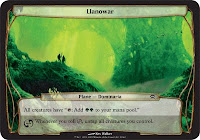 |
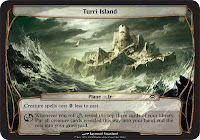 |
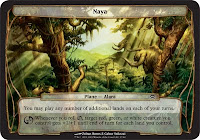 |
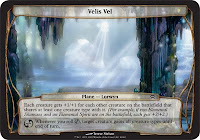 |
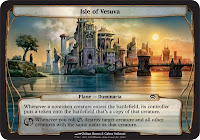 |
Elemental Thunder Deck List
9 Forest
9 Mountain
1 Fertilid
1 Blaze
1 Browbeat

















